
|
In this somewhat older 35mm picture, we can see Rumeli Hisari from across the Bosphorus.
Rumeli Hisari, the Fortress of Europe, was built on the orders of Sultan Mehmed II ("the Conqueror") in 1452,
just prior to his conquest of Constantinople.
From left to right, we see the towers of Zaganos, Halil, and Saruca Pashas.
|
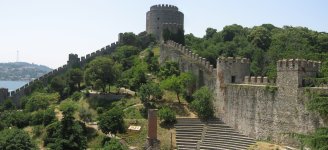 A close look at the flowerbed indicates that the fortress was constructed in 1452.
The ruined minaret of the original castle mosque is also visible.
Restoration of the castle began in 1953, the 500th anniversary of the conquest.
The interior of the castle is now used as an open-air theater (several rows of seats are visible in this picture).
The large tower in the background is the tower of Zaganos Pasha.
A close look at the flowerbed indicates that the fortress was constructed in 1452.
The ruined minaret of the original castle mosque is also visible.
Restoration of the castle began in 1953, the 500th anniversary of the conquest.
The interior of the castle is now used as an open-air theater (several rows of seats are visible in this picture).
The large tower in the background is the tower of Zaganos Pasha.
|
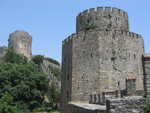
|
In the foreground is the twelve-sided Tower of Halil Pasha. In the rear is the Tower of Saruca Pasha.
Construction of the three main towers was assigned to a separate vezir.
Competing against each other, their construction crews completed the castle in approximately
four months.
|
 This is the view from the Tower of Saruca Pasha, looking down at the Tower of Halil Pasha and the Bosphorus Strait.
The original purpose of this castle was to cut off shipping to Constantinople prior to the conquest.
Along with a smaller fortress (Anadolu Hisari) on the Asian shore, the combined firepower of the two castles
could prevent any ship from passing the Bosphorus.
This is the view from the Tower of Saruca Pasha, looking down at the Tower of Halil Pasha and the Bosphorus Strait.
The original purpose of this castle was to cut off shipping to Constantinople prior to the conquest.
Along with a smaller fortress (Anadolu Hisari) on the Asian shore, the combined firepower of the two castles
could prevent any ship from passing the Bosphorus.
|

|
In the background, we can see the Fatih Sultan Mehmed Bridge, spanning the narrowest part of the
Bosphorus Strait. This suspension bridge is one of the world's longest, spanning approximately 1510 meters.
We can also see a large cargo vessel returning from the Black Sea.
|
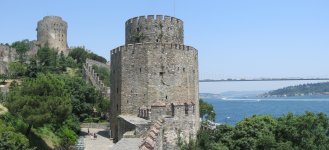 Near the modern bridge, the Persian King Darius I ("the Great") initiated one of the most ambitious
engineering feats of antiquity. In 512 BE, a bridge of boats was constructed across the Bosphorus for his
massive army.
Darius watched this feat from a stone throne hewn into the cliff where the northern
tower of Rumeli Hisari now stands. The throne of Darius and two commemorative columns
he erected were still visible at this site in late antiquity.
Near the modern bridge, the Persian King Darius I ("the Great") initiated one of the most ambitious
engineering feats of antiquity. In 512 BE, a bridge of boats was constructed across the Bosphorus for his
massive army.
Darius watched this feat from a stone throne hewn into the cliff where the northern
tower of Rumeli Hisari now stands. The throne of Darius and two commemorative columns
he erected were still visible at this site in late antiquity.
|
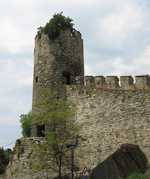
|
This is not a part of Rumeli Hisari, but rather part of Anadolu Hisari (the Fortress of Asia).
Built by Sultan Beyazit I Yildirim ("the Thunderbolt") around 1390, it is much
smaller than Mehmet's castle across the strait. It consists of a keep, an outer wall, and three towers.
It is possible that the some of the towers were added later by Mehmet II.
|
 In this panorama (taken from the tower of Zaganos Pasha), we can see the towers of Saruca and Halil Pashas,
the Fatih Sultan Mehmet Bridge, and the Bosphorus Strait.
In this panorama (taken from the tower of Zaganos Pasha), we can see the towers of Saruca and Halil Pashas,
the Fatih Sultan Mehmet Bridge, and the Bosphorus Strait.
|

|
This is Yedikule, the Castle of Seven Towers. This large castle was also built by
Mehmed II ("the Conqueror"), shortly after the conquest of Constantinople.
The name stems from the fact that the castle incorporates four towers from the original Theodosian walls along with
three towers built by Mehmed II. Standing atop one of the towers of this five-sided castle, we can see the Sea of Marmara.
Directly on the coast in the distance stands the Marble Tower, the remains of an ancient imperial sea pavilion.
|
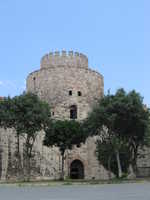
|
The castle often served as a prison. On many occasions, foreign envoys who displeased the sultan would be imprisoned here.
This was such a common occurrence that one of the towers is called the Tower of the Ambassadors.
The castle also served as a warehouse for the state treasury.
|
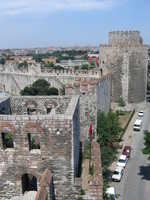
|
Yedikule was the scene of the execution of the sixteen year old
Sultan Osman II ("Young Osman") on May 22, 1622. Before his death he pleaded to his captors:
"Yesterday I was Padishah. Today I am stripped bare. Let me be an example to you. You also may
suffer the vicissitudes of fate in this world."
The Ottoman chronicler Evliya Celebi recalls that
"They carried him in a cart to Yedikule where he was barbarously treated and at last most cruelly
put to death by Pehlivan (the Oil Wrestler). Whilst his body was exposed upon a mat, Kafir Aga cut off his right ear and a Janissary one of his fingers for the sake of a ring upon it."
|
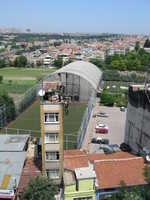
|
This is one of the most remarkable houses in the world. It can be seen from atop the walls of Yedikule.
|
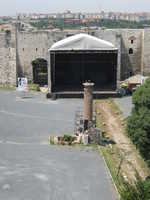
|
Currently, the castle serves as a venue for musical performances. The stage stands directly in front of the
famed Golden Gate of Byzantium. One can also see the ruins of a mosque, which stood in the courtyard until 1905.
According to the Book of Ceremonies, when a new ruler was acclaimed Augustus at the Hebdomon (the modern district of Bakirkoy)
the procession entered the city at the Golden Gate where the city
authorities welcomed him.
Yedikule incorporates four towers from the Theodosian walls, two of which are massive marble pylons which flank the Golden Gate.
|
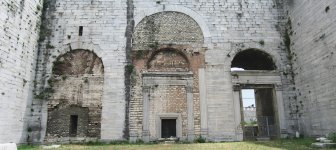 This is the famed Golden Gate (Porta Aurea) of Byzantium.
Perhaps only Haghia Sophia eclipses the Golden Gate in terms of laying out the entire history of
the city in one location.
This is the famed Golden Gate (Porta Aurea) of Byzantium.
Perhaps only Haghia Sophia eclipses the Golden Gate in terms of laying out the entire history of
the city in one location.
Originally built by Theodosius I ("the Great," reigned 379 - 395 CE) as a Roman triumphal arch in 390 CE,
it stood on the ancient Via Egnatia (a major Roman road, running from Constantinople, through the provinces of
Illyria, Macedonia, and Thrace to Dyrrachium on the Adriatic Sea),
about a mile outside of the walls erected by Constantine I ("the Great").
As such, the Golden Gate is similar to a classic Roman arch, with a triple arcade and a monumental arched portal flanked by two smaller ones.
The gates were originally plated in gold and the facade was decorated with sculptures.
A bronze group of four elephants and two winged victories commemorated the triumphal entry of Theodosius I after his victory over the usurper
Magnus Maximus (Maximianus). An inscription, now lost, boasted:
"Theodosius ornaments this gate after the suppression of the Tyrant [Maximus]. He who builds this Gate of Gold brings back the Golden Age."
When Theodosius II (reigned 408 - 450) extended the city two decades later, he incorporated the Golden Gate in the new Land Walls.
|
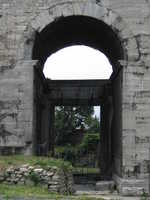
|
The Golden Gate was reserved solely for triumphant Byzantine emperor or honored guests.
The Golden Gate was the scene of several notable imperial triumphs. For instance:
Heraclius passed through the Golden Gate on September 14, 628 CE
along with the purported fragments of the True Cross (recovered from the Persians) and four elephants.
Leo III, commander of the Byzantine armies of Asia Minor,
usurped the throne and led his troops through the Golden Gate on March 25, 717 and was crowned in Haghia Sophia that afternoon.
In 763, Constantine V Copronymus ("the dung-named," so named by the iconodules in reference to an unfortunate incident during his baptism)
returned after his victory over King Teletz of the Bulgars.
|
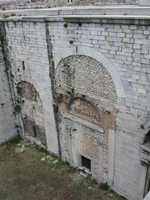
|
Other notable imperial triumphs include Basil I (reigned 867 - 886) and Basil II (reigned 976 - 1024) after further victories over the Bulgars,
John I Tzimisces (969 - 976) after his defeat of the Russians, and those of
Theophilus (829 - 842) and Michael III (reigned 842 - 867) after their victories over the Arabs.
The final use of the Golden Gate as the scene of an imperial triumph occurred on
August 15, 1261 when Michael VIII Palaeologus entered upon a white horse after recapturing
Constantinople from the Latins. This was the last time that an Emperor of Byzantium would ride in
triumph through the Golden Gate.
During its final two centuries, the Byzantines suffered defeat after humiliating defeat and
the Golden Gate was walled up for good.
|
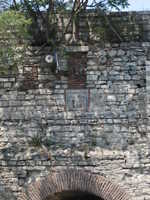
|
Upon leaving Yedikule, one immediately encounters a
Byzantine eagle engraved in the arch of Yedikule Gate.
This gate served as a public entrance to Constantinople, for the nearby
Golden Gate was reserved
for the emperor and distinguished visitors.
This series of pictures details the lengthy 6.5 kilometer walk along the massive Land
Walls of old Constantinople from Yedikule (the Castle of Seven Towers) on the shores of the
Sea of Marmara to the Golden Horn.
|

|
The Land Walls were built during the reign of Theodosius II
(reigned 408 - 450 CE). The first phase of construction
was completed in 413 under Anthemius, Prefect of the East.
This heavily damaged section of the walls permits us to examine a cross-section of the ancient fortifications.
The inner wall is 5 meters thick and 12 meters high, studded with 96 mighty towers, each 18-20 meters high and approximately 55 meters apart.
Between the inner and outer walls is a terrace between 15 and 20 meters in width.
The outer wall is 2 meters thick, 8.5 meters high, and reinforced with 96 towers which alternate in position with the towers of the inner wall.
Beyond the outer wall is another terrace, a short wall 2 meters in height, and then a moat 10 meters deep and 20 meters wide.
|

|
This is the Belgrade Gate, the largest of all of the ancient military gates.
Its modern Turkish name derives from the fact that Suleyman I ("the Magnificent") settled
hundreds of craftsmen he captured after conquest in of Belgrade 1521.
Nearby inscriptions, on eighth tower of the inner wall,
record repairs by the Emperors Leo III in 720 CE and his son Constantine V in 741.
The tenth tower of the outer wall also records repairs undertaken by
John VIII Palaeologus in 1434.
|
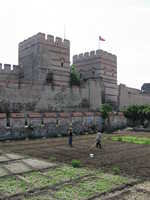
|
Looking back toward the Belgrade Gate, one can see the multiple layers of fortification enjoyed by
the Byzantines. The portion of the walls between the Belgrade and Silivri Gates is generally in good condition,
aided here and there by modern reconstruction work.
The Land Walls formed such an imposing barrier that even Attila the Hun did not attempt to
conquer Constantinople. Instead he opted to attack the remains of the Western Roman Empire.
|
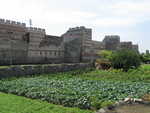
|
Along this section of the walls, all thirteen inner towers and all but one of the outer towers
are still standing. Near the Marmara portion of the walls are a number of small farms.
A notable siege of Constantinople began on July 17, 813 CE when Krum, Khan of the Bulgars, attacked.
A few years earlier, on July 25th 811, the Byzantine Emperor Nicephorus I
was killed in battle against the Bulgars. Krum then fashioned Nicephorus' skull into a stylish drinking
cup and then proceeded to the walls of Constantinople. Seeing that the city could not be taken by force,
Krum allegedly intimidated the garrison by performing human sacrifices in their sight. Emperor Leo V
attempted to lure Krum into an ambush by proposing negotiations. Krum escaped, swearing vengeance (he died on April 13, 814).
|
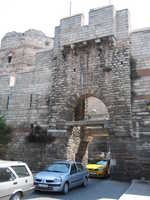
|
This is the Silivri (Selymbria) Gate, known in ancient times as the Gate of Melantias
(Porta Melantiados). An historic event took place here on July 25, 1261, when
a small group of soldiers of the Empire of Nicaea, under the command of their general Alexios Strategopoulos, forced the gate and
recaptured Constantinople from the Latins. This led to the restoration of the Byzantine Empire (1261 - 1453),
albeit in a permanently weakened form.
In the words of John Julius Norwich:
"From the start, the Latin Empire of Constantinople had been a monstrosity.
In the fifty-seven years of its existence it had achieved nothing, contributed nothing, enjoyed not
a moment of distinction or glory... its fall was, if anything, even more ignominious than its beginning -
overpowered by a handful of soldiers in a single night."
|
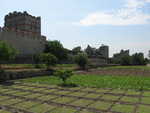
|
This portion of the walls is not as well-preserved as others.
Nevertheless, one can still imagine what a formidable obstacle the Land Walls posed to a
medieval army. Nearby is the Third Military Gate, over which once stood a famous
statue of Theodosius II (reigned 408-450 CE), the builder of the Land Walls. Unfortunately, this statue vanished in the
14th century.
|

|
This is (I think) the Mevlevihane Gate, known in ancient times as the Gate of Rhegium.
An inscription on the lintel reads: "This tower of the Theodosian wall was restored by Justin and Sophia, our most
pious sovereigns, and by Narses, the most glorious Spatharius and Sacellarius..."
This refers to the Emperor Justin II (reigned 565-578), the nephew and successor of Justinian.
Narses was the eunuch who succeeded Belisarius as commander of the Byzantine armies.
In 447 an earthquake leveled portions of the walls, destroying 57 defense towers.
With Attila the Hun and his Golden Horde fast approaching, the circus factions of the Hippodrome rebuilt the walls
under the supervision Constantine, prefect of the East.
An inscription in Latin and Greek at this gate states that:
"By the command of Theodosius, Constantine erected these strong walls in less than two months. Scarcely could Pallas herself have built so strong a citadel in so short a span."
|
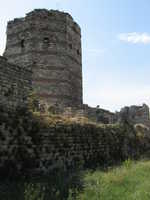
|
Portions of the Land Walls are overgrown with vegetation.
Another notable siege took place when the
Avars arrived on July 29, 626 and commenced their attack on July 31, 626.
Despite Persian naval support and heavy siege weaponry, the city did not fall.
The design of the traction trebuchets employed by the Avars originated in China.
Their first recorded use in a European theater (Thessalonica) dates back to 586 CE.
|
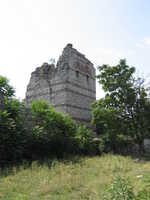
|
In some places, trees have taken root in the walls themselves.
On the afternoon on June 18, 860 CE, a fleet of 200 Russian warships sailed down the Bosphorus,
pillaging the dozens of towns dotting its shores, before anchoring in near the Golden Horn.
Meanwhile, the Emperor Michael III and his armies were engaged with the Arabs in Asia Minor.
Fortunately for the Byzantines, the raiders found Constantinople itself impregnable and
eventually sailed away of their own accord.
|

|
I have been unable to identify this ruined building. Perhaps it once functioned
as barracks for the troops. A nearby tower bears the inscription:"Oh Christ, God, preserve
thy city undisturbed and free from war. Conquer the wrath of our enemies."
|

|
A rough translation of this sign reads:
"On Tuesday morning, May 29, 1453 [the corresponding date on the Muslim calendar is also given]
the Conqueror's [i.e. Mehmet II's] army entered Istanbul
through a hole that the cannons opened in this region."
The successful charge through the breach was led by giant Janissary known as Hasan.
Although he perished in the battle, but the armies of Mehmet II were ultimately successful.
|
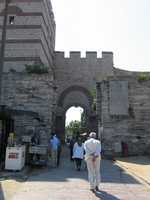
|
This is possibly the Fourth Military gate. The city
repelled previous Ottoman attacks in 1396 by Bayezit I Yildirim ("the Thunderbolt") and in
1422 by Murad II, before finally falling in 1453.
|
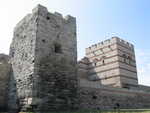
|
Here we can see a tower of the inner wall (restored) and a tower from the outer wall. In particular,
note their staggered placement.
|

|
At left, in the distance, is the mosque of Mihrimah Sultan. Dominating the Sixth Hill, it was built by the great architect Sinan for Princess Mihrimah,
the favorite daughter of Suleyman I ("the Magnificent"). At the time of this picture, its slender minaret is not visible, having been disassembled for
repair.
We can also see the Mesoteichion, the middle portion of the walls between Topkapi and Edirnekapi Gates,
sloping down into the Lycus Valley between the Sixth and Seventh Hills. This is lowest section of Theodosian walls and consequently it was
subject to heavy bombardment by the Turkish cannon during the final siege.
|
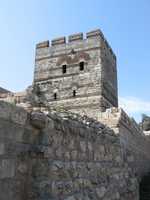
|
This picture was taken near where the modern street Vatan Caddesi pierces the walls between the Fourth and Fifth Military Gates.
During Byzantine times, Topkapi (the Cannon Gate) was called the Gate of St. Romanus, after a nearby church. The modern Turkish
name stems from the fact that Sultan Mehmet II ("the Conqueror") positioned his largest cannon (named Orban) near this gate.
|
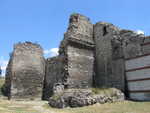
|
The is the Fifth Military Gate of ancient Constantinople. According to tradition, the last Byzantine Emperor,
Constantine XI Palaeologus (also called Constantine Dragases, as he was the grandson of the Serbian prince Constantine Dragas of Kumanovo),
had his command post nearby. He was last seen fighting here,
along with his cousins Theophilus Palaeologus and Don Francisco of Toledo.
|
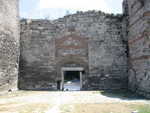
|
The Turkish name for the Fifth Military Gate is Hucum Kapisi, the Gate of the Assault.
The outer lintel of the gate records a repair undertaken by someone named Pusaeus in the 5th century.
Like the Golden Gate, this large portal clearly displays the
declining fortunes of the Byzantines. The size of the gate was reduced many times throughout
the course of the empire, until only a small doorway remained.
|

|
This ruined tower stands on the Mesoteichion, the lowest section of Theodosian walls where they cross the Lycus Valley.
Being below the level of the Turkish cannon at the time of the siege, this stretch of walls is heavily damaged.
|
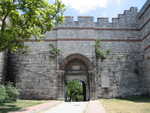
|
This is the ancient Gate of Charisius (Porta Charisiou), known in Turkish
as Edirnekapi ("Gate of Adrianople").
It stands on top of the Sixth Hill and is the highest geographical point in the ancient city.
This is also where Mehmed II ("the Conqueror"), then only twenty-one,
made his triumphal entry into the conquered city.
|

|
This sign records the fact that on May 29, 1453, Sultan Mehmet II ("the Conqueror") and his armies entered the city through Edirne Gate.
The Ottoman chronicler Evliya Celebi, one of whose ancestors was present at the event, wrote:
"The Sultan then having the pontifical turban on his head and sky-blue boots on his feet, mounted on a mule
and bearing the sword of Mohammed in his hand, marched in at the head of seventy or eighty thousand Muslim heroes,
crying out 'Halt not conquerors! God be praised! Ye are the conquerors of Constantinople!'"
|
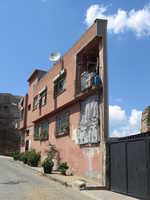
|
This is a peculiar house located just inside the Theodosian walls near the Edirne Gate. The house, built on a
triangular plot of land, appears to be flat when viewed from the correct angle.
Just down the road from this house are the ruined
Palaces of the Porphyrogenitus and Blachernae.
I also took another picture
of the same house on an earlier trip to Istanbul. In particular, you can see that the owners upgraded to
satellite television, as have most Turks.
|
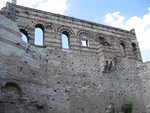
|
These are the ruins of Tekfur Saray, known in English as the
Palace of the Porphyrogenitus.
Built in late 13th or early 14th century, it served as the imperial residence
during the last two centuries of the Byzantine Empire.
It is in fact a three-story building built between inner and outer walls of the Theodosian fortifications.
The red brick and white marble design is typical of later Byzantine architecture.
|
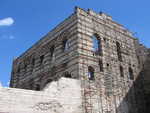
|
During the 16th and 17th centuries, the palace was used by the Ottomans to house large animals such as elephants and giraffes.
In 1595, the English traveler Fynes Moryson saw "A beaste newly brought out of Affricke, which beaste is
altogether unknowne in our parts. He many times put his nose in my necke, when I thought my selfe
furthest distant from him, which familiarity I liked not; and howsoever his Keepers assured me he would not hurt me."
|
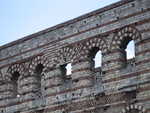
|
By the end of the 17th century, the animals were removed and the palace reduced to a brothel.
In 1719, the building was converted into a pottery plant. By the late 18th century the palace
lost its roof and floors, eventually serving as a poorhouse during the first half of the 19th century.
In more recent times, it has served as a bottle works and warehouse. It is currently being restored.
|

|
In this older (35mm) picture, we see some ruined towers that one formed part of
the Palace of Blachernae and various other buildings. I had the chance to enter the ruins of Blachernae and explore the
extensive (six story+) substructure.
The story of the walls near the Golden Horn is somewhat convoluted.
Portions were added by Heraclius in 627 CE to protect the city against the approaching Avars and Persians.
In 813, Leo V added an outer wall and four small towers to protect against Krum and the Bulgars.
Manuel Comnenus (reigned 1143 - 1180) added nine towers and one public gate (now known as Egri Kapi) during his reign.
Further inscriptions indicate substantial additions and repairs in
1188 by Isaac II Angelus, 1317 by Andronicus II Palaeologus, and 1441 by John VII Palaeologus.
|
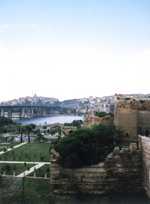
|
Another older photo (35mm) of the Land Walls and a bridge over the Golden Horn.
The street level to the right of the picture is (after 1000 years) now
at the level of the wall itself. There are many Byzantine era substructures
that are readily accessible to the intrepid adventurer. Indeed, the
children in this neighborhood grow up exploring the ruins underneath their houses.
The terrace upon which Ivaz Efendi Mosque sits is the site of the Palace of Blachernae.
Built by the Emperor Anastasius around 500 CE, it was used by imperial family when
visiting nearby Shrine of Blachernae. It was rebuilt by Comnenus dynasty during 11th and 12th centuries.
After the Byzantine restoration in 1261, the Great Palace on the First Hill
was abandoned altogether and the imperial family lived exclusively at Blachernae.
|
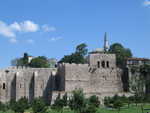
|
The so-called Prison of Anemas and Tower of Isaac Angelus are built into the walls near the Golden Horn.
At least six Byzantine emperors were imprisoned, tortured, mutilated, and/or blinded in this place
and at least two of them were murdered there.
Emperor Isaac Angelus was imprisoned in the Prison of Anemas and blinded (the traditional Byzantine punishment for deposed emperors).
He was restored briefly in 1213, ruling with his son Alexius IV. The following year, both were deposed, imprisoned, and
strangled to death.
|

|
The Tower of Isaac Angelus was built in 1188 as a private imperial apartment.
One can still see the shafts of columns that once supported its elaborate balconies.
|
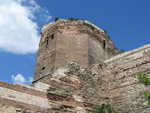
|
A close look at this tower reveals two crosses embedded in the brickwork.
|

|
This gate was known in ancient times as the Kaligaria Pyle, or the "Gate of the Bootmakers' Quarter". It was here that the last
Emperor of Byzantium, Constantine XI Palaeologus (Dragases), was last seen alive by his friend George Phrantzes.
According to Phrantzes, on the night of May 28, 1453, Constantine assembled the members of his household and bid
them farewell:
"Who could describe the tears and groans in the palace? Even a man of wood or stone could not help weeping."
The Emperor and Phrantzes parted at this gate, the emperor riding to his post near the Fifth Military Gate
where he died the following morning.
The Turkish name Egri Kapi (the Crooked Gate) stems from the fact that road sharply detours around the tomb
of Hazret Hafiz, a companion of the Mohammed. According to legend, Hazret Hafiz was killed on this spot
during the first Arab assault on Constantinople in 674. Several other Arab heroes are purported to be buried in the vicinity.
The tomb of Hazret Hafiz was discovered in the 18th century by the Chief Eunuch Besir Aga, who built the tomb which currently blocks the road.
|

|
Several other notable Arab warriors fell before these walls during
the first Arab assault on Constantinople in 674. A small graveyard here marks the graves of
Ebu Seybet ul-Hudri and Hamd ul-Ensari, two companions of Mohammed. Further up the Golden Horn is
the tomb of Eyup Ensari, the standard bearer of Mohammed and his last surviving companion.
His tomb is considered one of the holiest Muslim sites in Istanbul. Strangely,
the tomb appears to have survived an additional 779 years of Byzantine rule. Indeed,
an Arab traveler during the reign of Manuel I Comnenus (reigned 1143 - 1180) claimed that the tomb
still existed in his day. Moreover, the traveler Zakariya al-Kazwini (c. 1203 - 1283) asserted that
"This tomb is now venerated among them [the Byzantines] and they open it when they pray for rain in times
of drought; and rain is granted them."
|
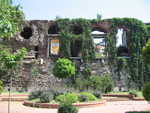
|
The Sea Walls originally enclosed the two sides of Constantinople which were exposed to the Sea of Marmara and the Golden Horn, respectively.
The Great Palace of the Byzantine Emperors consisted of many smaller palaces. Among them were the
Sacred Palace, the Palace of Daphne, the Palace of Chalke (located near the present Blue Mosque), the Palace of Magnaura,
the Palace of Mangana (southeast of Haghia Sophia), and the sea-palace of Bucoleon.
At one time, Bucoleon Palace was part of the Great Palace of the Byzantine Emperors and sat high atop the
massive Sea Walls of Constantinople. A small private harbor once allowed the emperors to board their imperial
ships here.
In the eastern loggia of palace, we can see three marble framed windows and a great vaulted room behind them.
The projecting corbels indicate that a balcony ran along facade.
The square marble slabs visible in the lower portion of the wall are actually Doric capitals from the 5th century BCE, taken from an ancient temple that stood nearby.
|

|
Aside from the Mosaic Museum near the Blue Mosque, this is all that remains of the Great Palace,
built by Constantine during the foundation of new capitol.
Destroyed in Nika revolt of 532 CE, it was rebuilt by Justinian I ("the Great," reigned 527 - 565)
and Basil I ("the Macedonian," reigned 867 - 886).
In the 1204 sacking of Constantinople during the Fourth Crusade, Bucoleon was taken by Boniface of Montferrat who:
"rode all along the shore to the palace of Bucoleon, and when he arrived there it surrendered, on condition that the lives of all therein should be spared.
At Bucoleon were found the larger number of the great ladies who had fled to the castle, for there were found the sister of the King of France, who had been empress,
and the sister of the King of Hungary, who had also been empress, and other ladies very many.
Of the treasure that was found in that palace I cannot well speak, for there was so much that it was beyond end or counting."
On May 9th, 1204, the Latin conquerors of Constantinople elected Baldwin of Flanders as their new leader.
He was crowned the following day and then moved into the Palace of Bucoleon.
|
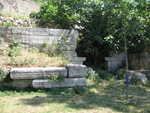
|
This is the Cracked Gate (Catladi Kapi). The remains of finely carved acanthus leaf decorations
can still be seen. This was originally the imperial marine gate attached to the port of Bucoleon, the private
harbor of the Byzantine Emperors.
|
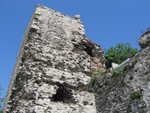
|
The Marmara defenses consisted of a single line of walls 12 to 15 meters high,
studded with 188 towers. The Sea Walls run for a distance of eight kilometers and
originally boasted 13 sea-gates.
|
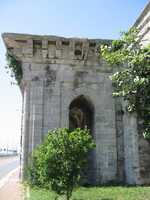
|
This marble structure is called the Incili Kosk, the Pavilion of the Pearl.
An inscription on a nearby fountain indicates that it was built in 1578. Originally part of an outer
pavilion of Topkapi Palace, this pavilion was favored by Sultan Murad III who spent his final
days in January 1595 there.
|
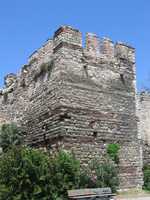
|
The inscriptions on this tower date to the reign of the Emperor Theophilus (829 - 842 CE).
A rough translation can be found written on the bench below (joke).
|

|
This is a view of the Sea Walls from Topkapi Palace. A modern road has been built on landfill outside the original walls themselves
while trains run just inside of the walls.
|
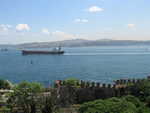
|
In this view (from the upper reaches of Gulhane Park), one can see large vessels passing from the Sea of Marmara
to the narrow Bosphorus Strait which separates Europe and Asia.
|
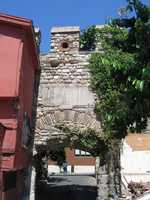
|
Ottoman inscriptions can be seen on this gate.
|
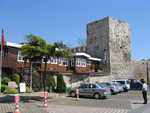
|
In many places, modern buildings have been built on top of the Sea Walls.
|

 A close look at the flowerbed indicates that the fortress was constructed in 1452.
The ruined minaret of the original castle mosque is also visible.
Restoration of the castle began in 1953, the 500th anniversary of the conquest.
The interior of the castle is now used as an open-air theater (several rows of seats are visible in this picture).
The large tower in the background is the tower of Zaganos Pasha.
A close look at the flowerbed indicates that the fortress was constructed in 1452.
The ruined minaret of the original castle mosque is also visible.
Restoration of the castle began in 1953, the 500th anniversary of the conquest.
The interior of the castle is now used as an open-air theater (several rows of seats are visible in this picture).
The large tower in the background is the tower of Zaganos Pasha.

 This is the view from the Tower of Saruca Pasha, looking down at the Tower of Halil Pasha and the Bosphorus Strait.
The original purpose of this castle was to cut off shipping to Constantinople prior to the conquest.
Along with a smaller fortress (Anadolu Hisari) on the Asian shore, the combined firepower of the two castles
could prevent any ship from passing the Bosphorus.
This is the view from the Tower of Saruca Pasha, looking down at the Tower of Halil Pasha and the Bosphorus Strait.
The original purpose of this castle was to cut off shipping to Constantinople prior to the conquest.
Along with a smaller fortress (Anadolu Hisari) on the Asian shore, the combined firepower of the two castles
could prevent any ship from passing the Bosphorus.

 Near the modern bridge, the Persian King Darius I ("the Great") initiated one of the most ambitious
engineering feats of antiquity. In 512 BE, a bridge of boats was constructed across the Bosphorus for his
massive army.
Darius watched this feat from a stone throne hewn into the cliff where the northern
tower of Rumeli Hisari now stands. The throne of Darius and two commemorative columns
he erected were still visible at this site in late antiquity.
Near the modern bridge, the Persian King Darius I ("the Great") initiated one of the most ambitious
engineering feats of antiquity. In 512 BE, a bridge of boats was constructed across the Bosphorus for his
massive army.
Darius watched this feat from a stone throne hewn into the cliff where the northern
tower of Rumeli Hisari now stands. The throne of Darius and two commemorative columns
he erected were still visible at this site in late antiquity.

 In this panorama (taken from the tower of Zaganos Pasha), we can see the towers of Saruca and Halil Pashas,
the Fatih Sultan Mehmet Bridge, and the Bosphorus Strait.
In this panorama (taken from the tower of Zaganos Pasha), we can see the towers of Saruca and Halil Pashas,
the Fatih Sultan Mehmet Bridge, and the Bosphorus Strait.
















































